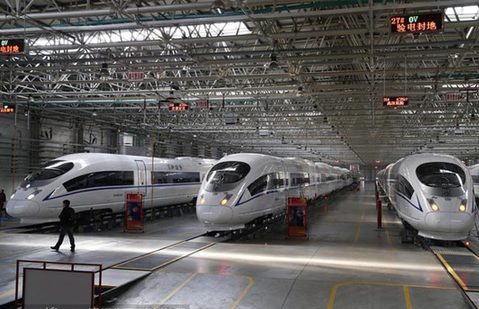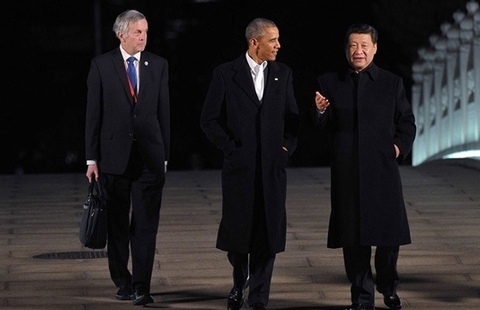
Zhai Qing:
Honestly, the efforts in implementing the 10 provisions of the action plan have really paid off, and this should be attributed to the hard work of various localities and departments. At department level, the State Council decided on 22 auxiliary policies to assist the action plan, and 19 of them have been released last year. Departments including the National Development and Reforming Commission and the Ministry of Housing and Urban-Rural Development have sent representatives here today, and they have been dedicated to the mission of pollution reduction. It is also true of the localities. In particular, the staff members have worked in real and concrete terms in the three key regions, which consist of 11 provinces, autonomous regions or municipalities. One example of this is Lanzhou city in Gansu province. Last year at similar date, I mentioned the experience of the city, as well as Taiyuan city in Shanxi province. Work undertaken by localities such as these have been truly effective.
Cooperation between cities has also been effective. This was especially so in the Beijing-Tianjin-Hebei region and the Pearl River Delta region, and it achieved great success in ensuring the air quality for the APEC meetings in Beijing, the Youth Olympic Games in Nanjing and the national memorial day in Nanjing. Due endorsement should be given to the relevant localities and departments.
Zhai Qing:
However, while we have made certain progress, we cannot rest. Air pollution remains a serious issue. Of the 74 cities, only eight lived up to the national standards in 2014 although five more cities were included compared to 2013. The low level of those meeting the national standards should not be ignored. The Beijing-Tianjin-Hebei region remains one of the most seriously polluted regions in the country. Preliminary surveys show that some provinces — those having not been chosen as priority regions — even witnessed their levels of PM 10 increasing rather than dropping. We will conduct further evaluations concerning this. When we were doing the surveys, we also found that some provincial governing bodies have prioritized the problem, but the pressure has not been delivered to the governing bodies among the lower ranks, such as the cities and counties. The emphasis was not sufficient. We will take follow-up measures to review and address such problems.
Zhai Qing:
Also, I would like to elaborate on three more points. First, the air quality impact imposed by one city on an adjacent one should not be exaggerated. Some documents and media reports have shown that some seriously polluted cities attributed their problems to the impact imposed by other cities, in some cases up to more than 50 percent. That is to say, they believe that half of the local pollution stems from other cities. Outside influences do exist, and the impacts are indeed serious in some places. However, the impact should never be exaggerated, and responsibilities should not be shirked. Such exaggerations definitely exert a negative influence on our efforts in tangibly implementing the measures decided. All the localities should be serious in this regard.
Second, priorities should be given to addressing weather conditions exacerbated by serious pollution. These conditions can be hazardous and the public has voiced its concerns. We also share these concerns. As we all know, one day of serious pollution offsets a dozen days of blue skies. Therefore, localities should place emphasis on addressing pollution, and resolute measures should be taken at once and emergency responses initiated to spare no effort in lowering emissions in the event of such problems, especially in winter.
Third, improving air quality is a challenging and complex task. Recent media reports said some localities have tried to get their names off a blacklist by introducing measures that are short term. There are also people who say that the battle to improve air quality is too slow to harvest remarkable progress. This may be understandable, but a clear picture should be seen when it comes to the major factors behind pollution. Polluting emissions remain a huge problem. And this is of great relevance to our economic and energy structures, ways of productions and lifestyle. It takes time to resolve such problems. Acting hastily may derail our efforts in implementing relevant measures, and may even lead to fake progress or cheating in statistics. We should maintain a strong sense of urgency and responsibility. We cannot make errors of omission just because they don’t pay immediate results. We should address the entirety of the problems.
Bloomberg News:
I have a question for the vice minister of Environmental Protection. Deputy Mayor of Beijing Wang Anshun commented that Beijing is not a livable city at the moment and the top priority will be pollution control this year. I wonder if you have any response to his remarks which seemed rather strongly worded? Thank you.
Zhai Qing:
There seems to be much public attention concerning Beijing’s efforts to tackle pollution. Regarding the work in 2014 — the Party committee and municipal government of Beijing made things clear during the municipal Two Sessions, which were held not long ago.
Last year, Beijing made remarkable progress. The use of converted coal-fired steam boilers with capacity of 6595 tons of steam cut the use of coal by 2.8 million tons. The city took 480,000 aging vehicles off the roads and ensured that most of the vehicles that failed to meet the European No.1 standard for exhaust emissions were scrapped.
Additionally, a total of 390 enterprises have been closed down, investigations were launched concerning more than 2900 cases related to environmental crime, and the authorities also issued fines amounting to a total of 105 million yuan.
Of course, a great deal remains to be accomplished in Beijing concerning the government’s bid to improve air quality. We believe that the municipal administration, with support from relevant national departments, will be able to continue to make improvements. Thank you.
Reporter:
Mr Qi, I’m very interested in the renovation of shanty houses that you have just mentioned. According to the media release, China renovated more than five million shanty houses last year. Do you have any good experience to report? What is the proportion of these five million renovated houses among the whole workload? How long will it take to complete all renovation work so that all those in need have a house to live in?
Qi Ji:
I have just given you some figures on renovation of shanty houses during the 12th Five-Year Plan (2011-2015). I have mentioned three points. First, we have carried out a series of policies in terms of financial input, reducing taxes, credit support, land supply and multichannel financing to ensure the capital for renovation work. Second, authorities at all levels are working together to back up the associated policies. Third, local governments are paying a lot of attention to this task and have listed it as a major government project this year because it helps improve living standards.
Qi Ji:
In recent years we have talked of several aspects that can ensure the renovation work will be carried out smoothly.
First, the fundamental goal of renovating shanty housing is to assist people to improve their living conditions with the government’s help. Such projects should benefit anyone whose old houses are being renovated so they can live in better and bigger houses. The measures widely adopted now are providing an apartment of 30 square meters to a household to replace one of the same area that has been demolished. In other places, the policies are even more preferential. While the shanty houses are poorly-equipped, without kitchens or toilets, the renovated houses are equipped with kitchen, toilet and even a living room, and they are at least 40 square meters, larger than the original ones. So residents can benefit from renovated shanty houses in this way. This is the most successful experience we’ve got.
Second, we have promoted transparency and fairness in renovating and distributing houses. To ensure transparency, detailed resettlement plans must be publicized before renovation projects begin. This innovative arrangement has won the respect and support of residents living in shanty areas.
Moreover, the high attention that governments at all levels attach to this at all levels is very important. During the 12th Five-Year Plan (2011-2015), the government’s work reports have spelled out the goals and tasks in affordable housing projects from 2011 to 2014, including the renovation of shanty houses. I think this year’s government work report will be no exception. Such top-to-bottom attention has ensured the implementation of related policies.
Though we still face many difficulties, all the work has been done in a smooth way over the past few years, as the figures show.








